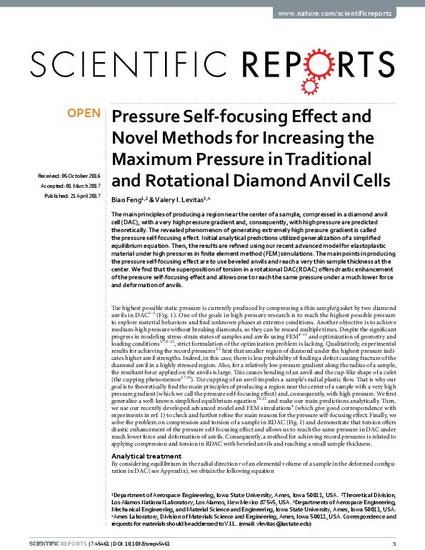
Article
Pressure Self-focusing Effect and Novel Methods for Increasing the Maximum Pressure in Traditional and Rotational Diamond Anvil Cells
Scientific Reports
Document Type
Article
Disciplines
Publication Version
Published Version
Publication Date
9-1-2017
DOI
10.1038/srep45461
Abstract
The main principles of producing a region near the center of a sample, compressed in a diamond anvil cell (DAC), with a very high pressure gradient and, consequently, with high pressure are predicted theoretically. The revealed phenomenon of generating extremely high pressure gradient is called the pressure self-focusing effect. Initial analytical predictions utilized generalization of a simplified equilibrium equation. Then, the results are refined using our recent advanced model for elastoplastic material under high pressures in finite element method (FEM) simulations. The main points in producing the pressure self-focusing effect are to use beveled anvils and reach a very thin sample thickness at the center. We find that the superposition of torsion in a rotational DAC (RDAC) offers drastic enhancement of the pressure self-focusing effect and allows one to reach the same pressure under a much lower force and deformation of anvils.
Creative Commons License
Creative Commons Attribution 4.0
Copyright Owner
The Authors
Copyright Date
2017
Language
en
File Format
application/pdf
Citation Information
Biao Feng and Valery I. Levitas. "Pressure Self-focusing Effect and Novel Methods for Increasing the Maximum Pressure in Traditional and Rotational Diamond Anvil Cells" Scientific Reports Vol. 7 (2017) p. 45461 Available at: http://works.bepress.com/valery_levitas/72/

This article is published as Feng, Biao, and Valery I. Levitas. "Pressure self-focusing effect and novel methods for increasing the maximum pressure in traditional and rotational diamond anvil cells." Scientific Reports 7:45461 (2017). doi: 10.1038/srep45461. Posted with permission.